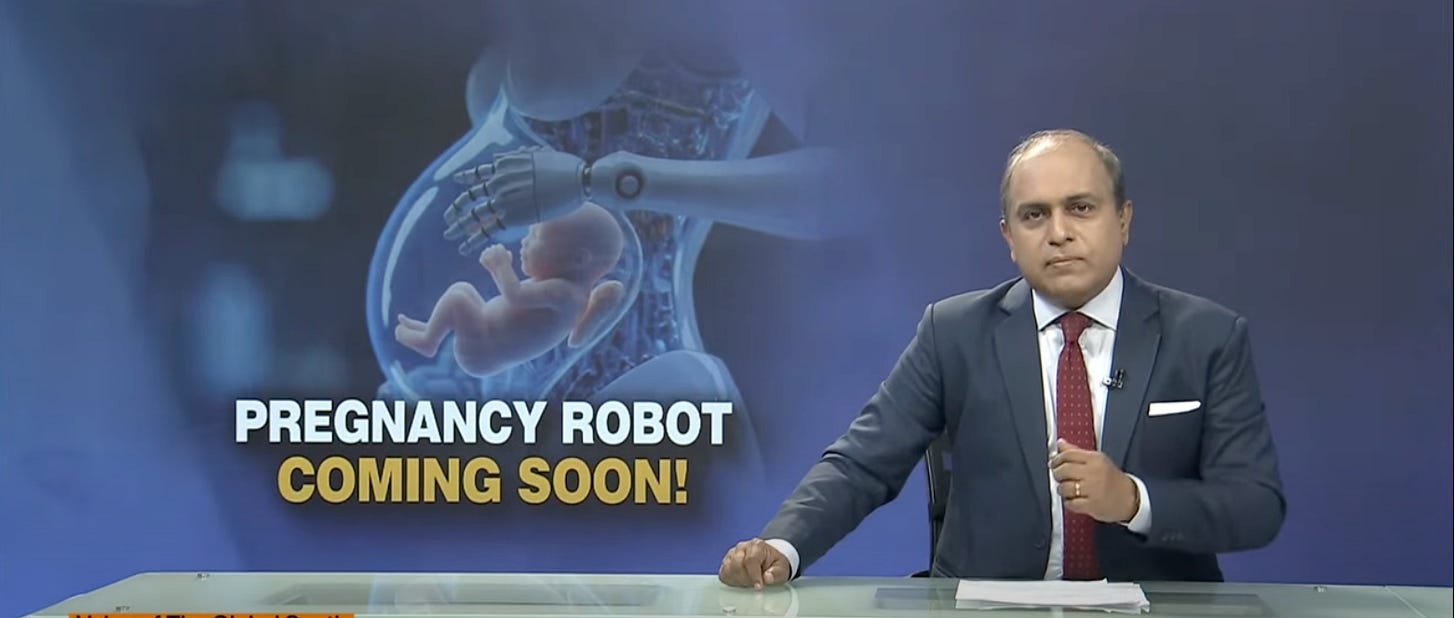#148: 🤖🤱 The "Pregnancy Robot" Hoax
And what it reveals about the real future of artificial wombs
Hey Friends,
Thank you to all of you who subscribed and upgraded to the paid tier of Nina’s Notes!
Your support means I can continue dedicating the time needed to research, interview experts, and break down complex studies into the insights you love.
For those still thinking about it, no pressure at all. I genuinely appreciate that you're here reading, sharing with friends, and engaging with this community we've built together.
Whether you're a free or paid subscriber, you're part of something special, a group of curious humans who believe science should be understandable and actionable for everyone.
Are you ready to support Nina's Notes?
Thank you all so so much!
Now, let's dive into this week's topic...
💬 In this note:
🤖🤱 The "Pregnancy Robot" Hoax
📚 100x
⚡️ Seahorse Morning Dance
#148: 🤖🤱 The "Pregnancy Robot" Hoax

Well, this is a perfect reminder of why we need to be critical consumers of science news and cautious of clickbait.
In mid-August, a story about a Chinese "pregnancy robot" went absolutely viral, featuring images of chrome-plated robots with babies curled inside their bellies.
The story claimed a Chinese company called Kaiwa Technology was developing this humanoid robot with an artificial womb, with prototypes ready by 2026 for around $14,000.
Live Science investigated and found no evidence of Kaiwa Technology existing, and Nanyang Technological University confirmed they have no PhD graduate named Zhang Qifeng leading such a project and no such research happening there.
While this specific story was fabricated, the underlying science of artificial wombs is very real.
The Real Science Behind Artificial Wombs
While the pregnancy robot was fake, the underlying technology is very real and actively being researched.
This isn't designed to carry a pregnancy from conception, but rather to support extremely premature babies born between 23-28 weeks.
In 2017, the CHOP team successfully kept fetal lambs alive in their "biobag" for a month, with the lambs developing much as they would in a natural womb.
The device includes a bag of lab-made amniotic fluid and an external oxygenator that mimics placental function.
The team is preparing for human trials soon.
Other researcher groups are working on artificial placentas that would fulfill the same purpose as EXTEND, supporting premature babies.
These devices have also been tested on lambs but are farther out from human trials than EXTEND is.
What's Missing In An Artificial Womb Compared to the Human Experience?
There are many technical challenges to replicating the womb biologically.
But he finds it intellectually interesting to consider the challenges because "it helps us actually reflect about what is the beauty and miracle of a normal pregnancy."
In natural pregnancy, a fertilized embryo must implant in the uterine wall.
However, in an artificial womb, some experts argue that the implantation step may be less critical, leading to more successful pregnancies.
Others argue implantation is critical and you'd need to recreate uterine tissue.
Early in pregnancy, the womb maintains a low-oxygen environment to protect dividing embryo DNA from free radicals.
Around week 8, this transitions to higher oxygen levels, but we do not know what dose of oxygen is needed at any given stage of development.
Getting oxygen levels wrong could be catastrophic for fetal development.
There may also be a higher infection risk without the immune system of the mother to protect the womb and fetus.
Maintaining a sterile environment for that long while providing nutrients and removing waste is an enormous engineering challenge.
In natural pregnancy, maternal antibodies pass to the fetus through the umbilical cord, which is why vaccines are given during pregnancy.
A robot pregnancy would need to replicate this immune protection somehow.
Lastly, the vaginal microbiome appears to impact fetal development, but we don't fully understand which microorganisms are helpful.
Plus, all that plastic in the robot or artificial womb could have unknown effects on development.
But there's a whole other layer we haven't even talked about yet, all the non-biological aspects of pregnancy that might be crucial for development.
Does the gentle sway of a pregnant person walking help stimulate the baby's vestibular system?
What about hearing their parent's voice from the inside, or the muffled sounds of daily life, music, conversations, even the rumble of traffic?
These aren't strictly biological functions of the womb, but they're part of the rich sensory environment that every naturally-developing fetus experiences.
An artificial womb might nail the oxygen levels and nutrient delivery perfectly, but could it replicate a parent's humming lullabies or the rhythmic sounds of breathing and heartbeat that babies have been listening to for millennia?
We honestly don't know what we might be missing.
The Potential Is Still Revolutionary
Even though full artificial gestation faces enormous hurdles, the potential implications are worth considering.
China is facing a serious fertility crisis, with infertility rates rising from 11.9% in 2007 to 18% in 2020.
For couples struggling with infertility, pregnancy complications, or medical conditions that make carrying a pregnancy dangerous, even the theoretical possibility of artificial wombs offers hope.
There are also many potential applications which make the artificial womb worth developing.
Women who've had hysterectomies could still have biological children.
Cancer patients undergoing treatment wouldn't have to choose between their health and fertility. (Many women who freeze their eggs do so before undergoing cancer treatment, as most chemotherapeutics target rapidly dividing cells - like fertilized eggs).
Same-sex male couples could have biological children without surrogacy.
The physical and career penalties women face during pregnancy could become optional.
As noted in early discussions about this technology, this could significantly reduce gender inequality in the workplace by removing "the high burden of pregnancy."
Space Exploration
Here's something you might not have thought about, artificial womb technology could be essential for human space exploration.
Pregnancy in zero gravity presents massive challenges we haven't solved.
Radiation exposure, bone density loss, and the unknown effects of microgravity on fetal development make traditional pregnancy during long space missions extremely risky.
But artificial wombs?
They could potentially be shielded from radiation and programmed to simulate Earth-like conditions for developing fetuses.
For generation ships or Mars colonies, this technology might not be optional, it could be necessary for human survival beyond Earth.
The Ethics
Of course, this isn't without serious concerns.
Public reaction has been mixed, with many people expressing unease about "disconnecting" pregnancy from the human body.
Valid concerns include:
Could this technology lead to discrimination against "natural" pregnancy?
What happens if something goes wrong with the artificial system?
How do we prevent this from becoming a luxury only available to the wealthy?
Are we losing something fundamentally human about the reproductive experience?
The Miracle of What We Take For Granted
As Dr. Kliman told Live Science:
"We're just little feeble beings trying to conceive of some way to do this artificially, and look at what nature has done. And it happens four million times a year in our country; we get a normal delivery. So that's the miracle."
The hoax story last month highlighted how fascinating the real science of artificial wombs truly is, and how much we still don't understand about the incredible complexity of human reproduction.
The technology for supporting premature babies is advancing rapidly and could save countless lives and I’m glad the article circulated to get the conversations going.
Though, we might not be ready for it to exist yet, because, nature has figured out pregnancy in ways we're only beginning to appreciate.
📚 Book of the Week
100X by Matt Leta
Rating: ★★★★☆
This book hit my reading list at exactly the right time, when AI discussions seem to swing wildly between "robots will replace us all" and "it's just fancy autocomplete."
Matt Leta manages to find the practical middle ground that executives actually need.
Leta focuses on the strategic question that actually matters: how do you systematically integrate AI into your business operations to create exponential rather than incremental improvements?
The book delivers on its promise of being a roadmap.
The real-world case studies span companies of different sizes, which is refreshing - too many business books assume everyone reading is running a Fortune 500 company.
The emphasis on culture and change management alongside technology implementation shows Leta understands that most AI initiatives fail due to people problems, not technical ones.
The sections on helping teams overcome AI anxiety and resistance are particularly well done.
This is clearly written for leaders who know they need to do something about AI but don't know where to start.
If you're already knee-deep in AI implementation, you'll find it too basic.
But if you're feeling overwhelmed by the pace of change and need a practical starting point, this book serves as a solid bridge between confusion and action.
The writing is executive-friendly - concise, jargon-free, and focused on outcomes rather than processes.
You can read it on a long flight and walk away with a clear sense of next steps.
⚡️ Check This Out

Did you need an excuse to dance in the kitchen over morning coffee with your partner today?
Well, here it is!
And it's backed by some seriously adorable marine biology.
Seahorse couples perform a daily morning dance ritual, and it's not just Instagram-worthy cuteness.
This behavior is actually a sophisticated survival strategy that could teach us humans a thing or two about maintaining strong relationships.
Seahorses form incredibly strong monogamous bonds, ride-or-die partnerships that last entire breeding seasons, and sometimes for life.
But they live in environments with powerful ocean currents and countless hiding spots.
Imagine trying to find your partner in an underwater maze every single day!
So they came up with an awww worthy solution…
A coordinated morning dance that puts even the most romantic couples to shame.
This isn't just a quick "good morning" either.
They take several minutes of synchronized swimming, complete with color changes, perfectly timed movements, and tail intertwining (awwww, right?!)
This daily dance isn't just about reaffirming their partnership.
The ritual actually synchronizes their reproductive cycles and reduces stress hormones.
These daily check-ins keep their bond so strong that when it's time to mate, they're perfectly aligned both emotionally and physiologically.
And in case you didn’t know before in seahorse relationships, it's the male who carries the babies.
During mating, the female deposits her eggs into the male's specialized brood pouch, where he fertilizes and carries them until birth.
Talk about sharing parenting duties!
This is a rare example in nature where devotion, cooperation, and shared responsibilities are woven into a daily routine.
The seahorses have figured out that consistent, small gestures of connection are more powerful than occasional grand romantic gestures.
Humans, take note. ;)
🗣️ Looking for the Nina’s Notes Podcast?
It’s available on: 🟢 Spotify, 🟣 Apple Podcasts, 🟠 Substack Podcasts
On the Nina’s Notes Podcast I interview entrepreneurs who are building products based on the science that I write about in the Nina’s Notes Newsletter.
You’ll also find voice overs of all the weekly Nina’s Notes.



